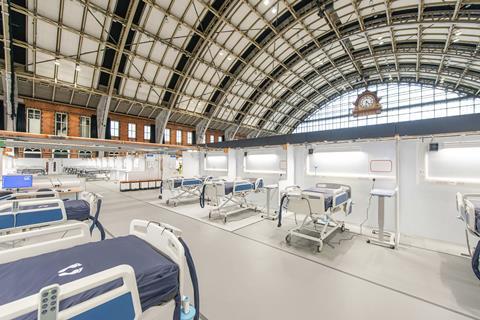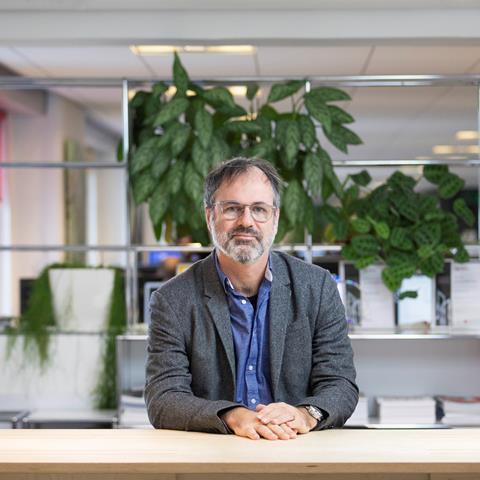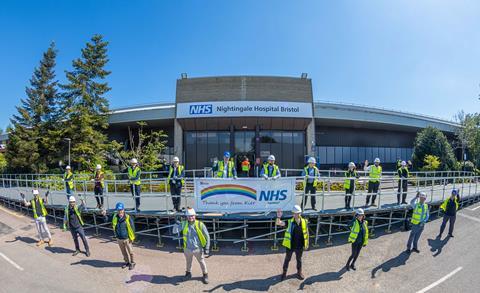A range of pandemic-prompted innovations have changed industry practice for good. Josephine Smit talks to those who led the way

From тАЬBuild back betterтАЭ to тАЬNever let a good crisis go to wasteтАЭ, politicians and business leaders have no shortage of aphorisms and slogans to apply to new ways of working in the wake of the pandemic. While for many, changes in the way they operate have been driven by two years of abnormal trading conditions, enforced lockdown closures or large-scale working from home, some working in construction had a very different experience to draw on.
They are the consultants, contractors, specialists and suppliers involved in delivering pandemic-related facilities like Nightingale hospitals and testing facilities. While others temporarily slowed or halted operations, these businesses and individuals found themselves working harder and faster than ever to respond to the emergency. Within the common and familiar foundations of the ProCure22 framework and NEC3 contract, project participants excelled and innovated in their processes and practices to deliver what was needed.
The resulting projects have, in many cases, already been dismantled, but the ways of working adopted to deliver them have left their mark. Some project participants have developed new practices, while for others the experiences have confirmed the value of approaches promoted through reports ranging from Sir John EganтАЩs Rethinking Construction to the governmentтАЩs current Construction Playbook. At the same time, projects have highlighted the gap between the everyday and best practice, giving the broader industry much to think about.
WhatтАЩs best for the project?
With six Nightingales to its credit, interdisciplinary design consultant BDP was more involved than many in pandemic projects. The ProCure 22 framework meant the practice found itself working with partners it already knew from previous projects. тАЬSo straight away there was almost an alliance approach, with people bringing the right skills to projects,тАЭ explains Nick Fairham, chief executive of the practice and lead on its Bristol and Cardiff Nightingales. тАЬWe knew how we worked, how the framework worked, we had a track record and a pre-formed team, so could hit the ground running.тАЭ With the supply chain on board early, the architect could identify any challenges and design around them from the outset.

BDPтАЩs Nightingale at the ExCeL Centre, in London, was the first of its kind and demanded prototyping to evolve requirements for medical processes such as тАЬdonning and doffingтАЭ тАУ putting on and taking off PPE. The practice prototyped the standard components for the London project and rolled successful options out across others.
The wider use of this kind of prototyping has been accelerated by the Nightingale projects, and is helping clients understand their options, as Fairham outlines: тАЬA client might say a bed space needs to be a certain size. We could say that would deliver 100 beds in a hospital but a compromise could deliver 150, and demonstrate that through prototyping. Suddenly you are in a dialogue where you are adding value through knowledge and innovation.тАЭ
This prototyping approach goes hand in hand with the practiceтАЩs use of technology to help people engage with design, which saw the company create QR code-accessible drawings of the 4,000-plus rooms of its new Grange University Hospital in Cwmbran.
Straight away there was almost an alliance approach, with people bringing the right skills to projects
Nick Fairham, BDP
Fairham describes the design and delivery process for the Nightingales as seamless, and something that is being enabled through digital engineering and Revit. The practice created a standard cubicle design, taking on board factors including space standards, work sequencing, materials specification, the equipment inside cubicles and their users. Now the firm is going further by looking at standardising processes and design components for new hospitals, taking on board efficiency, sustainability and whole-life value. Fairham explains: тАЬWith a digital engineering approach, 80% of a building is standardised тАУ and that creates time and space to focus on the other 20%, the elements that have more engagement with the users and more risk.тАЭ

The practice is developing a suite of rooms via the New Hospital Programme, with the aim of ultimately creating around 70 standard rooms covering key elements. тАЬItтАЩs a performance-based specification, so doesnтАЩt preclude market competition,тАЭ adds Fairham, who hopes this will ultimately become a tool for the industry.
With a digital engineering approach, 80% of a building is standardised тАУ and that creates time and space to focus on the other 20%
Nick Fairham, BDP
Above all, BDPтАЩs experience on these projects has given it a new mantra in the question: WhatтАЩs best for the project? тАЬIf you think about that, it helps foster collaboration and innovation, and drives value for money. ItтАЩs something weтАЩre using a lot more in terms of our terminology,тАЭ says Fairham. The projects saw unified teams working towards common goals. тАЬOne lesson weтАЩve learned is to have empathy for other peopleтАЩs targets within a project,тАЭ he adds. The shift towards NEC contracting is indicative of broader recognition of the benefits of collaboration, Fairham points out, and he sees that shift continuing with the NEC4 alliance contract, which is being used by the partners of Hallam Alliance тАУ including BDP тАУ on projects for Sheffield Hallam University.
Supporting stakeholders
Many of those involved in the pandemic healthcare construction projects talk of the unusual degree of empathy and collaboration engendered among clients and stakeholders, designers, delivery team and the supply chain. While the emergency situation and the intensity of working relationships were unique to the pandemic, the achievements have provided some food for thought for the construction industry. тАЬWe always try to create a common goal, but working in the Nightingales gave a sense of purpose and buy-in right from the start of the project. The experience has made us more aware of the impact that can have,тАЭ says Cheryl Parsons, health sector director at Kier Group.
Working in the Nightingales gave a sense of purpose and buy-in right from the start of the project. The experience has made us more aware of the impact that can have
Cheryl Parsons, Kier Group
Kier worked on the 300-bed Bristol Nightingale, created in a conference centre at the University of the West of England in just 20 days by a team also including BDP and Faithful+Gould. The contractor relied largely on familiar ProCure22 processes, templates and communication routes as the foundation of its working approach. тАЬWe needed to fast-track every aspect of design and delivery, but underpin it with the certainty of tried and tested processes and procedures, to make sure we could deliver everything right first time,тАЭ says Parsons. The firm brought in an experienced team and a supply chain with the right attitude and behaviours, because, she continues, тАЬThe ability to problem-solve was key, to quickly assess solutions, particularly for their suitability for a clinical environment and their impact on the running of a live hospital.тАЭ

The Nightingales demonstrated the value of Teams and other digital platforms to provide ready means of communication and information-sharing, and to drive rapid decisions тАУ which on the Bristol project often had to be made within an hour. тАЬWe used digital platforms to ensure the whole client, design, delivery and supply chain had access to information immediately. As soon as a decision was made, everybody saw everything,тАЭ says Parsons.
These tools are now helping not only to speed up decision-making but also to increase stakeholder engagement. тАЬWeтАЩre currently using the approach across a number of live schemes,тАЭ she explains. тАЬIt allows people to contribute at a time that suits them, which is important as our healthcare clients are often balancing huge pressures of delivering clinical services while making decisions on project designs.тАЭ
We used digital platforms to ensure the whole client, design, delivery and supply chain had access to information immediately. As soon as a decision was made, everybody saw everything
Cheryl Parsons, Kier Group
Parsons says KierтАЩs experience has given a deeper appreciation of client needs and so how to drive improved decision-making and solutions. тАЬA key lesson for us has been around supporting stakeholders so that they have the right level of information to make decisions and can understand their impact,тАЭ she explains.
She sees many elements of the Construction Playbook in the approaches promoted to deliver the Nightingales, including the use of digital and technology, collaboration and early engagement and integration with the supply chain. With materials supply lines disrupted during the pandemic, early supply chain engagement became pivotal and allowed the contractor to pursue product-led design solutions. BDPтАЩs standardised design for the Nightingale тАУ and the how-to guide it created alongside this тАУ was also a game-changer, paving the way for the contractor to add its own innovations, such as in establishing a near-site prefabrication area for services and bedhead trunkings.
In all, six contractors worked across the Nightingales тАУ and they worked collaboratively with each other too. тАЬWe were never in competition on individual programmes; we shared materials, managed the design team together and shared ideas. IтАЩve never seen anything like that before,тАЭ admits Parsons. тАЬThe experience highlighted the benefits of the ProCure22 approach for delivery and is potentially industry-changing. I hope we can continue to build on it.тАЭ
Fundamentally changing the business approach
Pandemic projects have had a significant impact on modular solutions provider Premier Modular. тАЬWeтАЩve fundamentally changed our business approach and become a slicker business because of what weтАЩve learned,тАЭ says managing director David Harris. The firm was involved in two initiatives: the Nightingale Exeter and provision of 50 standalone covid test sites for locations from Portsmouth to Inverness. For the former, the firm worked with Bam Construction, Arup and T Clarke, providing a 1,700m2 modular building that wrapped around a former superstore to double its size.
















